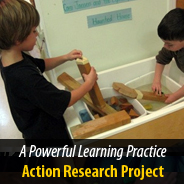The Shipley School
Team Members: Antonia Angeles L. Gonzales, Beth Boreanaz, Liz Cousins, Sondra Greenberg, Connie Morin, Kristin Shipler, Mark Tassoni, Deb Veraldi, Tina Wattles, and Wendy Eiteljorg.
Community: ADVIS Year 1, 2010-2011
As we began our PLP experience, we became interested in PBL and the possibilities for our students. We spent time investigating the model, learning more, and looking for examples in our own school. After determining that there were not many true PBL units in our classes, we decided to work on increasing the use of PBL in our school. To do that we first had to develop our own understanding of PBL and our own sense of being a learning group. Once we learned about PBL through Buck Institute online tutorial, we used their planning sheets to develop our own PBL units which we reviewed in critical friend groups. Our plan for next year is to teach our units, thus adding to PBL units taught at the school, and to expand schoolwide knowledge of PBL ideas.
The issue we have chosen to address is to increase the understanding and use of PBL in our classrooms. We chose this issue after becoming intrigued by the possibilities and upon review finding a lack of true PBL units in our classes.
- We wanted to build our human capital. We had found an issue to address in our classrooms, but were not ready to tackle it without expanding our own learning first. *We have all learned a lot about PBL though taking Buck Institute’s online tutorial.
- We wanted to come together as a group and develop a critical friends group. Our team consisted of teachers of preK-12 and many in between. Many of us did not know other team members well. *We have made a point to meet frequently and we have seen a lot of growth in our communication in terms of being able to give and receive constructive feedback.
- We wanted to create our own PBL units. *We have made good progress here. Using the Buck Institute planning forms we have each planned a unit.
- We wanted to teach those units. *Some of us have taught our units, others are planning units that will be taught for the first time next year.
- We wanted to continue to meet, beyond our year in PLP.
- We want to expand the use of PBL in classrooms in our school.
- We want to share our understanding with others.
School year 2010-11
- Complete Buck Institute Modules including assessment
- Meet with team after each Module to review learning and build team
- Plan individual PBL units step by step meeting as team to share and critique
- Met in smaller critical friends groups to get input on units
- Some PBL lesson taught
School year 2011-12
- Continue to meet as critical friends group
- Teach all PBL units
- Share our knowledge of PBL by guiding others in our divisions/departments through the Buck Institute online tutorial and bringing others into our critical friends group.
All team members have commented on the sense of community that has developed in our group. In addition as a group we have a good understanding of PBL and are beginning to spread the word.
About Action Research Projects
Action research is a process in which Powerful Learning Team members collaboratively examine their own educational practice systematically and carefully. Action research is:
- Disciplined inquiry into a problem or possibility within the school or classroom
- Collaborative and usually takes place in a community of practice
- Meaningful, positive, and reflective
- Data-driven, action-based, improvement-focused
- Transformative
View all Action Research
The following two tabs change content below.

Sheryl is the co-founder and Chief Executive Officer of Powerful Learning Practice. She works with schools and districts from around the world helping them to infuse technology into their curriculums and by leading other digital conversion efforts.
Sheryl also consults with governments, educational organizations and non-profits in development of their various professional learning initiatives.
Sheryl is a sought-after presenter at national and international events, speaking on topics related to digital and online learning, teacher and educational leadership, online community building, and other educational issues impacting children of poverty.
Sheryl served on the International Society for Technology in Education (ISTE) Board of Directors for six years. She co-authored The Connected Educator: Learning and Leading in a Digital Age with Lani Ritter Hall. Sheryl has four children and four grandsons, Luke, Logan, Levi and Tanner and a trio of dachshunds. You can find out more on her blog and on Twitter @snbeach.


